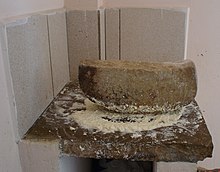Batan (stone)


The batán is a kitchen utensil used to process different kinds of foods in South American, Andean and Indian cuisine. It has a flat stone (the batán proper) and a grinding stone called an uña. The uña is held in both hands and rocked over the food in the batán. Depending on the process wished, the uña's weight is slightly held back, let loose over, or pressed on. The rocking movements also vary depending on the procedure. The grinding is done dry or with water or oil.
South America
The batán has been used since before the arrival of Spaniards in South America.
It is also used to husk grains, wash


South Asia
In Nepal, it is known as silauto-lohoro.
It is also used in
See also
References
- ISBN 9781603848565.
- ^ Morvelli, Walter Coraza "The Best Flavor in Cuzco’s Cooking Still Comes from the Batán, the Grinding Stones." 24 January 2013 Cusco Eats: Food and Culture of the Andes
- ^ A Feature on the Sil Batta – The traditional Stone Grinder of the Indian Kitchen" NMTV.tv March 3, 2011, Accessed March 4, 2017
- ^ "Bhimthadi Jatra: A melange of craftsmanship and tradition" December 13, 2014 The Times of India website, Retrieved March 4, 2017
- ^ [ta.wiktionary.org/wiki/அம்மி Meaning of the word in Tamil Wiktionary]
- ^ [ml.wiktionary.org/wiki/അമ്മി Meaning of the word in Malayalam Wiktionary]
